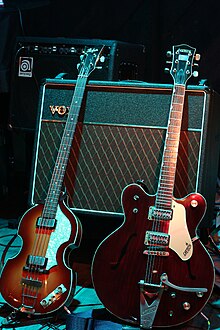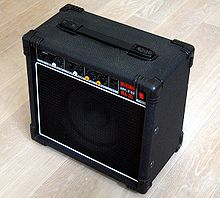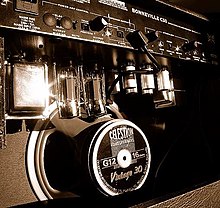Instrument amplifier
This article needs additional citations for verification. (July 2007) |
An instrument amplifier is an
Combination ("combo") amplifiers include a

Instrument amplifiers are available for specific instruments, including the
Unlike
Types
Guitar amplifiers

A

Standard amps
Standard amplifiers, such as the Fender "tweed"-style amps (e.g., the
These amps are designed to produce a variety of sounds ranging from a clean, warm sound (when used in country and soft rock) to a growling, natural overdrive, when the volume is set near its maximum, (when used for blues, rockabilly, psychobilly, and roots rock). These amplifiers usually have a sharp treble roll-off at 5 kHz to reduce the extreme high frequencies, and a bass roll-off at 60–100 Hz to reduce unwanted boominess. The nickname "tweed" refers to the lacquered beige-light brown fabric covering used on these amplifiers.
The smallest "combo" amplifiers, which are mainly used for individual practice and warm-up purposes, may have only a single 8" or 10" speaker. Some harmonica players use these small combo amplifiers for concert performances, though, because it is easier to create natural overdrive with these lower-powered amplifiers. Larger combo amplifiers, with one 12 inch speaker or two or four 10 or 12 inch speakers are used for club performances and larger venues. For large concert venues such as stadiums, performers may also use an amplifier "head" with several separate speaker cabinets (which usually contain two or four 12" speakers).
Hard rock and heavy metal

Electric guitar amplifiers designed for
In the late 1960s and early 1970s,
Amplifiers for harder, heavier genres often use valve amplifiers (known as "tube amplifiers" in North America) also. Valve amplifiers are perceived by musicians and fans to have a "warmer" tone than those of transistor amps, particularly when overdriven (turned up to the level that the amplifier starts to clip or shear off the wave forms). Instead of abruptly clipping off the signal at cut-off and saturation levels, the signal is rounded off more smoothly. Vacuum tubes also exhibit different harmonic effects than transistors. In contrast to the "tweed"-style amplifiers, which use speakers in an open-backed cabinet, companies such as Marshall tend to use 12" speakers in a closed-back cabinet. These amplifiers usually allow users to switch between "clean" and distorted tones (or a rhythm guitar-style "crunch" tone and a sustained "lead" tone) with a foot-operated switch.

Bass
Higher-cost bass amplifiers may include built-in
Bass amps may provide an XLR
Speaker cabinets designed for bass usually use larger
Speakers for bass instrument amplification tend to be heavier-duty than those for regular electric guitar, and the speaker cabinets are typically more rigidly constructed and heavily braced, to prevent unwanted buzzes and rattles. Bass cabinets often include bass reflex ports, vents or openings in the cabinet, which improve the bass response and low-end, especially at high volumes.

Keyboard
A
, all in a single cabinet.Notable exceptions include keyboard amplifiers for specific keyboard types. The vintage
Acoustic amplifiers
These amplifiers are intended for acoustic instruments such as violin ("fiddle"), mandolin, harp, and acoustic guitar—especially for the way musicians play these instruments in quieter genres such as folk and bluegrass. They are similar to keyboard amplifiers, in that they have a relatively flat frequency response and avoid tonal coloration.
To produce this relatively "clean" sound, these amplifiers often have very powerful amplifiers (up to 800 watts RMS), to provide additional "headroom" and prevent unwanted distortion. Since an 800 watt amplifier built with standard
Acoustic amplifier designs strive to produce a clean, transparent, "acoustic" sound that does not—except for reverb and other effects—alter the natural instrument sound, other than to make it louder. Amplifiers often come with a simple mixer to blend signals from a pickup and microphone. Since the early 2000s, it is increasingly common for acoustic amplifiers to provided digital effects, such as
Roles
Instrument amplifiers have a different purpose than 'Hi-Fi' (high fidelity)
Size and power rating
In the 1960s and 1970s, large, heavy, high output power amplifiers were preferred for instrument amplifiers, especially for large concerts, because public address systems were generally only used to amplify the vocals. Moreover, in the 1960s, PA systems typically did not use monitor speaker systems to amplify the music for the onstage musicians. Instead, the musicians were expected to have instrument amplifiers that were powerful enough to provide amplification for the stage and audience. In late 1960s and early 1970s rock concerts, bands often used large stacks of speaker cabinets powered by heavy tube amplifiers such as the Super Valve Technology (SVT) amplifier, which was often used with eight 10" speakers.
However, over subsequent decades, PA systems substantially improved, and used different approaches, such as horn-loaded "bass bins" (in the 1980s) and subwoofers (1990s and 2000s) to amplify bass frequencies. As well, in the 1980s and 1990s, monitor systems substantially improved, which helped sound engineers provide onstage musicians with a better reproduction of their instruments' sound.
As a result of improvements to PA and monitor systems, musicians in the 2000s no longer need huge, powerful amplifier systems. A small combo amplifier patched into the PA suffices. In the 2000s, virtually all sound reaching the audience in large venues comes from the
As a result, in many large venues much of the onstage sound reaching the musicians now comes from in-ear monitors, not from the instrument amplifiers. While stacks of huge speaker cabinets and amplifiers are still used in concerts (especially in heavy metal), this is often mainly for aesthetics or to create a more authentic tone. The switch to smaller instrument amplifiers makes it easier for musicians to transport their equipment to performances. As well, it makes concert stage management easier at large clubs and festivals where several bands are performing in sequence, because the bands can be moved on and off the stage more quickly.
Amplifier technology
Instrument amplifiers may be based on
Tube amplifiers
Vacuum tubes were the dominant active electronic components in amplifiers from the 1930s through the early 1970s, and tube amplifiers remain preferred by many musicians and producers. Some musicians feel that tube amplifiers produce a "warmer" or more "natural" sound than solid state units, and a more pleasing overdrive sound when overdriven. However, these subjective assessments of the attributes of tube amplifiers' sound qualities are the subject of ongoing debate. Tube amps are more fragile, require more maintenance, and are usually more expensive than solid state amps.
Tube amplifiers produce more heat than solid state amplifiers, but few manufacturers of these units include cooling fans in the chassis. While tube amplifiers do need to attain a proper operating temperature, if the temperature goes above this operating temperature, it may shorten the tubes' lifespan and lead to tonal inconsistencies.[2]

Solid-state amplifiers
By the 1960s and 1970s, semiconductor transistor-based amplifiers began to become more popular because they are less expensive, more resistant to bumps during transportation, lighter-weight, and require less maintenance. In some cases, tube and solid-state technologies are used together in amplifiers. A common setup is the use of a tube preamplifier with a solid-state power amplifier. There are also an increasing range of products that use digital signal processing and digital modeling technology to simulate many different combinations of amp and cabinets.
The output transistors of solid-state amplifiers can be passively cooled by using metal fins called heatsinks to radiate away the heat. For high-wattage amplifiers (over 800 watts), a fan is often used to move air across internal heatsinks.[3]
Hybrid
The most common hybrid amp design is to use a tube preamp with a solid state
See also
- Amplifier
- Electronic amplifier
- Guitar amplifier
- Guitar speaker
- Guitar speaker cabinet
- Isolation cabinet (guitar)
- Valve sound
- Bass instrument amplification
- Effects unit
- Distortion (guitar)
- Power attenuator (guitar)
- Sound reinforcement system
- Tone stack
References
- ^ Note: Acoustic amplifiers should not be confused with the amplifier brand name Acoustic, whose products are still available in the used equipment market.)
- ^ Cool it, man; Michael "Mac" McCullough.
- ^ Power Amplifiers - General Information: Yorkville Sound Archived 2010-10-07 at the Wayback Machine
External links
- Duncan's amp pages: information about valve (tube) guitar amplifiers
- List of books about guitar amplifiers and guitar amplifier tone
- Tons of Tones, a website for guitar amplifier modelling on digital multi-effect units Archived 2011-08-31 at the Wayback Machine
